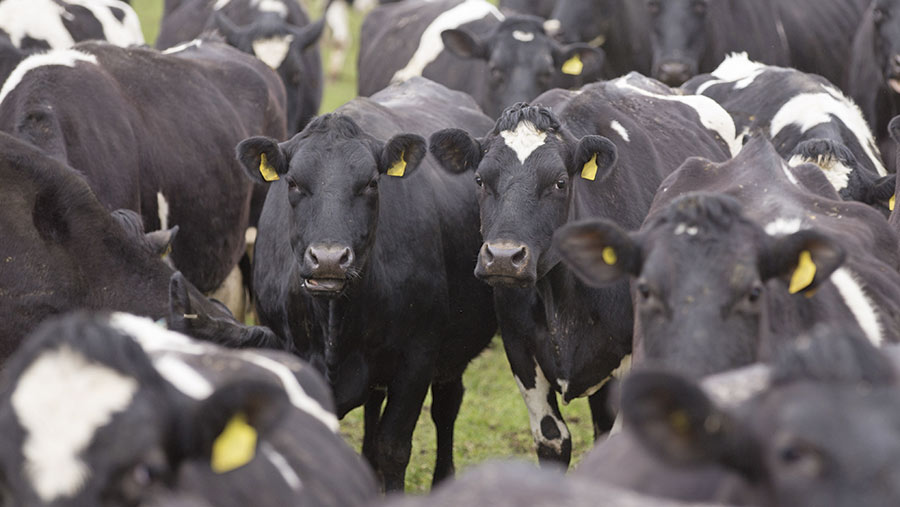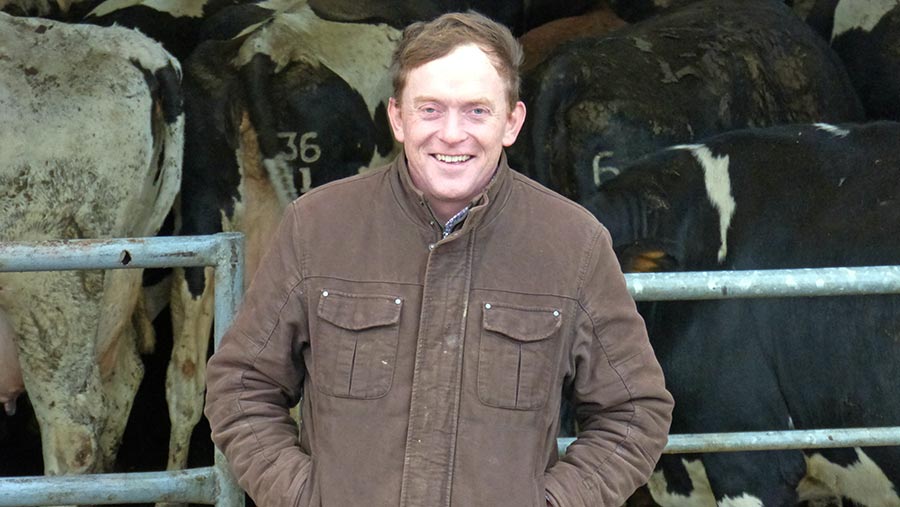How to decide if autumn block calving is right for your farm
 Dairy cows. © Tim Scrivener
Dairy cows. © Tim Scrivener All-year-round calving systems can be very profitable but, if not optimised, users may benefit from the efficiencies and focus of switching to autumn block calving, believes AHDB Dairy.
Currently, 81% of UK dairies are all-year-round calving and only 8% characterised as autumn-block calving. Those considering the switch and those already practising autumn-block calving are advised not to chase yields.
See also: How to budget for the switch to autumn calving
Instead, they are being encouraged to breed and manage for fertility and quality forage production to maintain a tight calving block.
Read the advice on what to consider in your buisness, an autumn block calving Q&A with dairy consultants and a case study on one farmer who made the switch to block calving.
9 things to consider before autumn block calving
Q&A on switching to autumn block calving:
Farmers Weekly asks Richard Davies of AHDB Dairy, dairy consultant Tony Evans of the Andersons Centre and Will Jones of Kite Consulting some key questions.
How will I manage calf rearing?
RD: If you are weaning at 12 weeks old it may be time to look at weaning at 10 or eight weeks because you will need space for all your calves to be on milk. (See point 7)
Farms have successfully built temporary calf pens with straw, bought polytunnels or calf igloos to rear batches of 10-12 calves for £1,500-£1,800/igloo.
Pressure can be completely taken off by having heifers reared on contract on a neighbouring farm, selling younger, increasing calf growth rates to wean younger, or having heifers contract reared until a shed is erected.
Red Tractor stocking rates are for 1.5m² per calf (50-84kg) then 1.8m² per calf (85-140kg) and then 2.4m²/calf (140-200kg). All stock must be able to lie down simultaneously, ruminate, rise, turn and stretch without difficulty.
Will I have to get more staff?
RD: Staffing will increase at calving but some farms will find that current staff levels are sufficient as the batch system brings efficiencies, although some farms get in an extra worker for three months calf rearing. (See point 6)
Specialising may help, for example have designated calf rearers and a grassland manager, herd manager and someone trusted with machinery. (See point 8)
How quickly should I get in the block?
TE: It can be done in one year but some manipulate calving dates, doing it in three to five years. The quicker the better as this means you are getting any cost-saving and lifestyle benefits sooner. Short-term pain for long-term gain should be the mindset.
Sell and buy back is the simplest option, but you need to identify correct replacements from as few sources as possible to reduce the biosecurity risk.
What will manipulating calving dates cost me in milk?
TE: If a hypothetical farm has 240 cows on a level calving pattern and it needs to leave cows open for an average of 120 days on two-thirds of the cows = 160 cows at a typical yield loss of 1,100 litres this would cost £51,040 at 29p/litre.
It can be important to keep cows milking rather than drying them off. If cows get fat they could lose their vigour to breed.
What is the cost of leaving cows open?
WJ: If we assume 25% of the herd already fits a three-month block from a true AYR calving herd, the remaining 75% will need to have lactations extended by up to nine months in order to fall back into the front of the block.
Using the figure of £4 loss for each additional day open the average cow will be extended by 4.5 months or 135 days – so the average cost per extended lactation is £540 or £54,000 per 100 cows.
What cows do I need for block calving?
TE: Farms with Holstein-Friesians may have to use Friesian bulls to breed more fertile replacements that will hold body condition better. However, some fertile Holstein families will manage it. Attention must be paid to condition and transition. (See point 9)
Many farms that have made the switch have used crossbred or Friesian genetics from Ireland on the EBI (economic breeding index) or the New Zealand breeding worth index. Your options are more open with autumn than they are for spring calving.
Autumn calving targets
- Calving periods must be no longer than 12 weeks
- 6,500-7,500 litres/lactation. Fertility must come first, do not chase yield
- 12ME silage. Quality forage will be essential when breeding all your herd inside at peak lactation in the autumn/winter
Source: John Olwen, Coleg Sir Gar’s Farm Manager, Gelli Aur, and Tom Renwick, dairy manager for Lord Newton, Uckfield, East Sussex
Case study: Hendrie Brothers, Kilmarnock, Ayrshire

Wallace Hendrie
Farm facts
- 900-cows across three different farms
- Purroch Farm is autumn calving since 2009 with 4ha of beet, 20ha of wheat
- Millands and Netherlands (added in 2012) both spring-block calving
- Managing 884ha including 100ha rented
- 22-point Dairymaster swingover parlour with ADF clusters
Since switching from AYR calving to ABC the Hendries at Purroch Farm have cut concentrate by 40% and quadrupled milk from forage (MFF) to 3,500 litres.
They focused efforts on improving grass utilisation and silage quality and are now targeting 4,000 litres from forage, feeding a TMR combining homegrown beet and crimped wheat.
At spring turnout, the farm sees a 1.5-llitre a cow/day production lift, explains Wallace Hendrie, who farms with brother James, Uncle Robert and father Jimmy near Hurlford, Kilmarnock. Wallace got the confidence to switch to block calving through his Nuffield scholarship and work with the Nuffield Dairy Group.
Cutting feed from 2.5t a cow at 6,500 litres to 1.5t a cow at 6,000 litres has left the Hendries better off overall, cutting feed costs from 8p/litre to 5p/litre.
As cattle dealers who were able to simultaneously start a spring-calving unit on neighbouring Millands Farm, the Hendries were ideally suited to make the switch as they could roll cows between calving blocks.
Purroch, the farm with the heaviest land, was already feeding a total-mixed ration and could house cows from calving in August, which took pressure off pasture when conditions are wet, explains Wallace.
Making the switch
The calving pattern was achieved by selling cows that didn’t fit either the spring system at Millands or the autumn system (12-week block from 1 August) at Purroch and rolling cows around between the two farms as necessary.
Experienced spring calver Tom Rawson was employed as a consultant. He told the Hendries that paddock grazing would grow 28% more grass so they would need 28% more cows, Therefore they have increased the herd from 220 to 300 cows.
Extra calf rearing space was made by reconfiguring pens. Calves were previously in single pens until weaning, but are now batch housed from 1-2 weeks old in groups of 12.
The Hendries also switched processor from First Milk to Muller on a liquid contract as this allowed them to be nearer to processing plants in their region and increased their milk price. Autumn-block cows average 4.32% fat and 3.5% protein.
Increasing milk from forage
- Calcium lime and calcium ammonium nitrate helped grassland productivity
- Soil pH lifted from 5.7 to an average of 6.2 and aiming for 6.5 before reseeding
- Moved to paddock grazing in 3-4.5 ha fields
- Entering paddocks at 2,800-3,000kgDM/ha and leaving at 1,500kg
- Field sizes mean 1-1.5 days in each paddock
- Added 1.2km of tracks and resurfaced tracks to get cows to pasture
